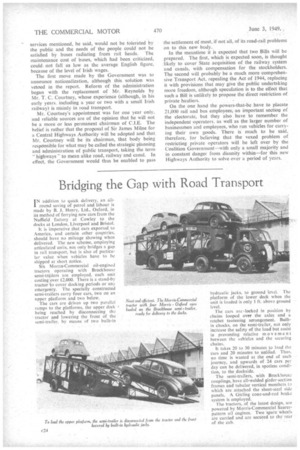Bridging the Gap with Road Transport
Page 24

If you've noticed an error in this article please click here to report it so we can fix it.
I N addition to quick delivery, an all
round saving of petrol and labour is made by B. J. Henry, Ltd., 'Oxford, in its method of ferrying new cars from the Nuffield factory at Cowley to the docks at London, Liverpool and Bristol.
It is imperative that cars exported to America, and certain other cottntries, should have no mileage showing when delivered. The new scheme, employing articulated units, not only bridges a gap in rail transport, but is also of particu. lar value when vehicles have 1.6 be shipped at short notice.
Six Morris-Commercial oil-engined tractors operating with Brockhouse semi-trailers are employed, each unit costing over £2,000. There is a stand-by tractor to cover docking periods or any emergency. The specially constructed semi-trailers carry four cars, two on an upper platform and two below.
The cars are driven up two parallel ramps to the platforms, the upper deck being reached by disconnecting the tractor and lowering the front of the semi-trailer. by means of two built-in hydraulic jacks, to ground level, The platform of the lower deck when the unit is loaded is only I ft. above ground level.
The cars are 'locked in position by chains looped over the axles and a ratchet tautening arrangement. Builtin chocks, on the semi-trailer, not only increase the safety of the load but assist in preventing relative movement between the vehicles and the securing chains.
It takes 20 to 30 minutes to toad the cars and 20 minutes to unlaad. Thus, no time is wasted at the end of each journey, and upwards of 24 cars per day can be delivered, in spotless condi
tion, to the dockside.
The semi-trailers, with Brockhouse couplings, have all-welded girder-section frames and tubular vertical members t3 which are attached the sheet-steel side panels. A Girling cone-and-rod brake system is employed. The tractors, of the latest design, are powered by Morris-Commercial Saurcrpattern oil engines. Two "spare wheels are carried and are secured to the rear of the cab.


























